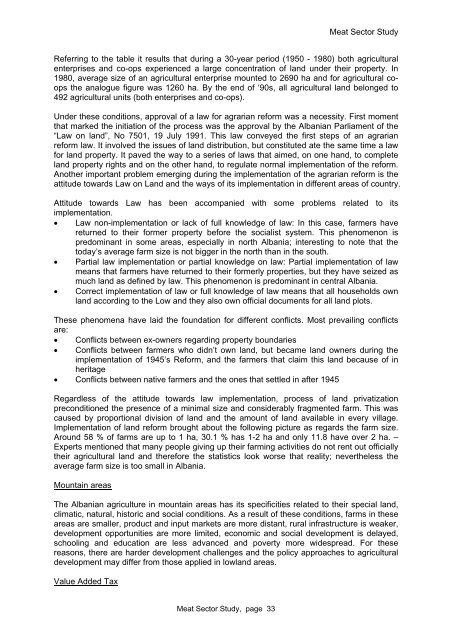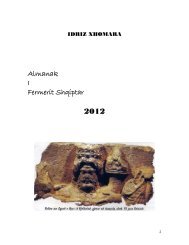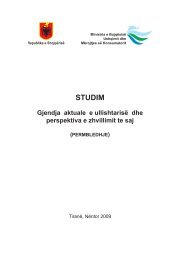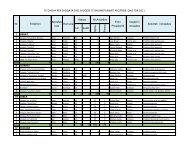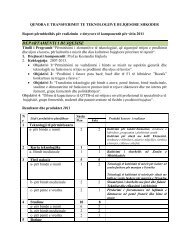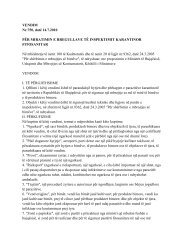MEAT Sector Analyse
MEAT Sector Analyse
MEAT Sector Analyse
- TAGS
- sector
- analyse
- mbumk.gov.al
You also want an ePaper? Increase the reach of your titles
YUMPU automatically turns print PDFs into web optimized ePapers that Google loves.
Meat <strong>Sector</strong> Study<br />
Referring to the table it results that during a 30-year period (1950 - 1980) both agricultural<br />
enterprises and co-ops experienced a large concentration of land under their property. In<br />
1980, average size of an agricultural enterprise mounted to 2690 ha and for agricultural coops<br />
the analogue figure was 1260 ha. By the end of ‘90s, all agricultural land belonged to<br />
492 agricultural units (both enterprises and co-ops).<br />
Under these conditions, approval of a law for agrarian reform was a necessity. First moment<br />
that marked the initiation of the process was the approval by the Albanian Parliament of the<br />
“Law on land”, No 7501, 19 July 1991. This law conveyed the first steps of an agrarian<br />
reform law. It involved the issues of land distribution, but constituted ate the same time a law<br />
for land property. It paved the way to a series of laws that aimed, on one hand, to complete<br />
land property rights and on the other hand, to regulate normal implementation of the reform.<br />
Another important problem emerging during the implementation of the agrarian reform is the<br />
attitude towards Law on Land and the ways of its implementation in different areas of country.<br />
Attitude towards Law has been accompanied with some problems related to its<br />
implementation.<br />
• Law non-implementation or lack of full knowledge of law: In this case, farmers have<br />
returned to their former property before the socialist system. This phenomenon is<br />
predominant in some areas, especially in north Albania; interesting to note that the<br />
today’s average farm size is not bigger in the north than in the south.<br />
• Partial law implementation or partial knowledge on law: Partial implementation of law<br />
means that farmers have returned to their formerly properties, but they have seized as<br />
much land as defined by law. This phenomenon is predominant in central Albania.<br />
• Correct implementation of law or full knowledge of law means that all households own<br />
land according to the Low and they also own official documents for all land plots.<br />
These phenomena have laid the foundation for different conflicts. Most prevailing conflicts<br />
are:<br />
• Conflicts between ex-owners regarding property boundaries<br />
• Conflicts between farmers who didn’t own land, but became land owners during the<br />
implementation of 1945’s Reform, and the farmers that claim this land because of in<br />
heritage<br />
• Conflicts between native farmers and the ones that settled in after 1945<br />
Regardless of the attitude towards law implementation, process of land privatization<br />
preconditioned the presence of a minimal size and considerably fragmented farm. This was<br />
caused by proportional division of land and the amount of land available in every village.<br />
Implementation of land reform brought about the following picture as regards the farm size.<br />
Around 58 % of farms are up to 1 ha, 30.1 % has 1-2 ha and only 11.8 have over 2 ha. –<br />
Experts mentioned that many people giving up their farming activities do not rent out officially<br />
their agricultural land and therefore the statistics look worse that reality; nevertheless the<br />
average farm size is too small in Albania.<br />
Mountain areas<br />
The Albanian agriculture in mountain areas has its specificities related to their special land,<br />
climatic, natural, historic and social conditions. As a result of these conditions, farms in these<br />
areas are smaller, product and input markets are more distant, rural infrastructure is weaker,<br />
development opportunities are more limited, economic and social development is delayed,<br />
schooling and education are less advanced and poverty more widespread. For these<br />
reasons, there are harder development challenges and the policy approaches to agricultural<br />
development may differ from those applied in lowland areas.<br />
Value Added Tax<br />
Meat <strong>Sector</strong> Study, page 33


